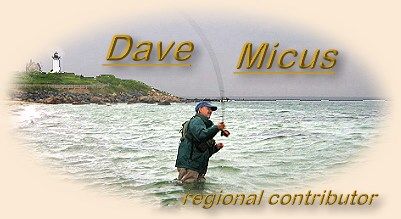|
As much as we Nor'eastern striped bass fishermen
don't want to admit, the last bass has reached
the Chesapeake by now, and we are left gazing at
the water with memories of the past season and
anticipation of the spring. And, though difficult,
you need to accept that the relationship really
is over and it's time to move on. A good way to
obtain closure is to store your equipment for the
winter. By servicing it and storing it properly,
you'll be ready when spring comes, and an angler's
fancy turns to striped bass.
There is an old fly-fishing adage that the sole
purpose of a reel is to store line. While that
might have been true of the old Catskill trouters,
whose fish were measured in inches, today's salt-water
fishers aren't spending $300 plus on a mere
line-storing device. We arm ourselves with
precision-machined reels in the hopes that maybe,
just maybe, the drag will withstand the searing run
of a hundred pound tarpon or the lengthy brawl of a
world record striper. To insure that it does, you
need to protect your investment with proper care.
I've been called a fanatic about reel care (by an
engineer, no less), and maybe I do take it to the
extreme. But early on in my salt-water career I
had the handle snap right off of a reel because
it corroded at the base, an area I never inspected.
This was in the middle of striper season and, as a
young father, I didn't have money for a replacement,
and the reel, a multiplier, had to be returned to
the factory. Had I only periodically removed the
handle knob and cleaned around the post, I wouldn't
have missed two weeks of striper fishing. Since
then I meticulously maintain my reels, and have
not had a problem since.
If you don't have one already, you need to make a
reel care kit. In your kit you should have a set
of jeweler's screwdrivers, alan wrenches (if needed),
small sockets and socket driver (again if needed),
reel lube, q-tips, a soft toothbrush, and alcohol
wipes. Determine from your reel's schematic any
spare parts you're likely to need and order them
in advance, things like springs, small screws, and
drag washers, and keep them in your kit. This will
save you a lot of time and heartache should something
like the spool release spring break in the middle of
fishing season. Minimize the schematic on a copying
machine, laminate it, and keep it with the rest of
your reel tools. Store your tools in a plastic
toolbox, or you can find something a little more
elaborate if you are, like me, into the rituals of
the sport (a friend who is a wood worker designed a
nice wooden box with a carved trout on the lid for
my tools).
Be prepared when cleaning your reel. Work at a
table with good lighting. Spread white paper so
you can see small parts, and use a plastic bowl
to hold tiny springs and screws. Don't work over
a floor that's carpeted. The first thing I do
when I buy a new reel, before putting on line
and backing, is to strip it right down to the
frame. I do this to familiarize myself with
every component of the reel, but also to loosen
things like the spool counter weight before
exposure to the salt freezes them in place. (If
you've had your reel for a bit and never stripped
it before, you might not be able to remove things
like the counter weight. If you can't, just clean
and lube around them the best you can.) Once you're
familiar with disassembling and assembling your reel,
you'll have no trouble maintaining it throughout
the season.
Thoroughly rinse your reel with fresh water after
every outing, and once a month disassemble it
including line and backing) to check for wear and
to clean and lubricate. Lightly scrub the frame
and spool with a soft toothbrush and soapy water.
Do the same to all the parts, except any drag
surfaces. Thoroughly dry everything, then take
your lubricant (I prefer Superlube) and a q-tip
and grease the entire reel, carefully avoiding
the drag. Pay particular attention to areas of
friction, like the spindle and the handle, but
lightly coating all non-drag surfaces will protect
your reel from the corrosive properties of salt
water. When you reassemble the frame and spool,
lubricate any surfaces you may have missed. Wipe
off the excess lubricant, and wind on the line
and backing.
At the end of the season, when storing your reel
for the winter, follow the above instructions except
don't wipe off the excess lubricant. Make certain
you've loosened the drag, put the reel in its case
and store it in a dry place. But before you do,
give the spool one good roulette-like-wheel turn
and admire that Swiss-watch-clicking-sound that
signifies a well-maintained reel. When the
striped bass return from the Chesapeake, you'll
be ready!
~ Dave
About Dave:
 Dave Micus lives in Ipswich, Massachusetts. He is an
avid striped bass fly fisherman, writer and instructor.
He writes a fly fishing column for the Port City Planet
newspaper of Newburyport, MA (home of Plum Island and Joppa Flats)
and teaches a fly fishing course at Boston University.
Dave Micus lives in Ipswich, Massachusetts. He is an
avid striped bass fly fisherman, writer and instructor.
He writes a fly fishing column for the Port City Planet
newspaper of Newburyport, MA (home of Plum Island and Joppa Flats)
and teaches a fly fishing course at Boston University.
|

 Dave Micus lives in Ipswich, Massachusetts. He is an
avid striped bass fly fisherman, writer and instructor.
He writes a fly fishing column for the Port City Planet
newspaper of Newburyport, MA (home of Plum Island and Joppa Flats)
and teaches a fly fishing course at Boston University.
Dave Micus lives in Ipswich, Massachusetts. He is an
avid striped bass fly fisherman, writer and instructor.
He writes a fly fishing column for the Port City Planet
newspaper of Newburyport, MA (home of Plum Island and Joppa Flats)
and teaches a fly fishing course at Boston University.